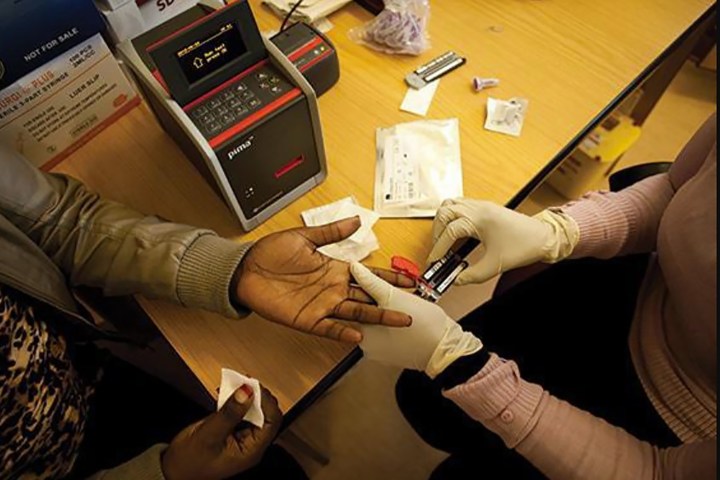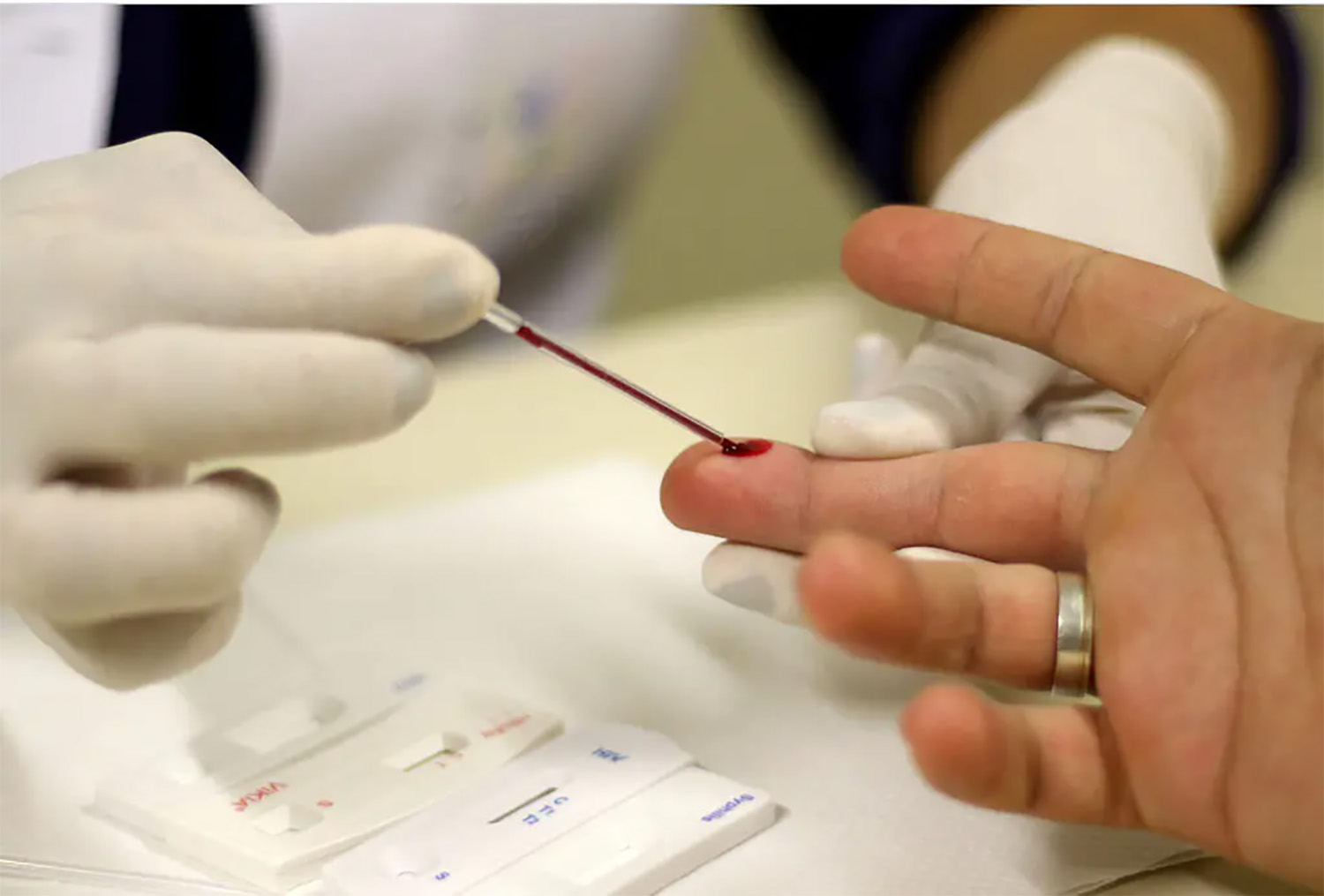DIAGNOSTIC ACCURACY OP-ED
HIV testing is changing in South Africa – here’s why it’s a good thing

South Africa has been using HIV rapid diagnostic tests (fingerprick, same-day testing) for years. Now, the Health Department has decided to align with the World Health Organization’s recommendation of a new three-test algorithm to ensure accuracy of results. René Sparks unpacks why this is important.
There are several reasons that South Africa has been using HIV rapid diagnostic tests for years. First, to save costs as the alternative, laboratory testing, is costly. Second, the rapid tests are reliable and can be used in any setting with fewer requirements than blood collection. Third, it provides same-day results, so people can start treatment earlier if they test positive and provide preventative services such as PrEP if they test negative. PrEP refers to pre-exposure prophylaxis – antiretrovirals taken to prevent HIV infection.
During HIV testing, the healthcare worker follows a standardised step-by-step process referred to as the HIV testing algorithm. This basically guides them to diagnose negativity or positivity using approved test kits. These kits change every three years, with the aid of the National Health Laboratory Service which tests the quality of the tests and their ability to accurately detect HIV positivity (referred to as sensitivity) and HIV negativity (specificity).
Since its implementation, South Africa has adopted a serial algorithm. This has involved first offering people a fingerprick test for HIV using a screening test with high specificity. The high specificity means that the risk of a false negative with this first test is extremely low, and accordingly, if someone tests negative no further test is required. If, however, there is a reaction on the first test, people would be offered another fingerprick test. This confirmatory test has higher sensitivity than the first and is accordingly less likely to yield false positives.

Rapid tests are affordable, reliable and provide same-day results: (Photo: Rodrigo Nunes / MS)
From two to three
Now, as South Africa approaches the amendment of our HIV Testing Policy, the Quality Improvement of HIV Rapid Testing Policy, and undertakes a new HIV rapid test tender, the Department of Health has decided to align with the World Health Organization’s recommendation of a three-test algorithm to ensure accuracy of HIV test results.
With this change, probably from later this year, people will be offered an additional fingerprick confirmatory test, referred to as the second confirmatory test.
Why is this important?
Unaids has set targets referred to as the 95-95-95 Strategy. These are also part of South Africa’s National Strategic Plan for HIV, TB and STIs 2023-2028. This means that 95% of people living with HIV should know their status, 95% of those who know their status should be on treatment, and 95% of those on ARVs should be virally suppressed. This is a critical HIV prevention strategy to get to zero HIV infections by 2030.
Based on Thembisa, the leading mathematical model of HIV in South Africa, the country’s progress toward the Unaids targets has been mixed. Estimates for 2022 suggest that progress towards the first target (95% of HIV-positive individuals diagnosed by 2025) is good and has been relatively uniform across provinces, “with most provinces at around 93%”.
On the second target, however, progress has been poor, with some provinces estimated to have only 68% (Limpopo) of people living with HIV on treatment, while most provinces are “close to reaching the third Unaids target (95% of ART patients virally suppressed with viral load)”.
The update states that “renewed efforts are needed in order to reach the Unaids targets” and “continued innovation in the field of HIV prevention will be critical”.
Reaching ‘saturation’
The WHO recommends the three-test algorithm to ensure the accuracy of results as we reach “saturation” (nearing the target of 95% of people living with HIV knowing their status).

Estimates for 2022 based on the Thembisa model suggest that South Africa’s progress towards the first Unaids target (95% of HIV-positive individuals diagnosed by 2025) is good. (Photo: Unicef Ethiopia)
The recommendation was made in 2019, but South Africa did not meet the eligibility criteria to implement it as we still had a high-yield (HIV positivity rate) at that time. We are now seeing a decrease in the test positivity rate and it is now important that we ensure that we do not miss anyone.
Read more in Daily Maverick: Experts question whether SA should invest in latest HIV tests
In short, it is getting harder to find people living with HIV, so we have to start using a finer-tooth comb. Adding a second confirmatory test is an obvious way to add that additional sensitivity and specificity.
The two-test algorithm has served us very well to date, but it is in the interest of the public that we now recalibrate our testing algorithm for our current reality. We have come a long way since the initial roll-out of HIV rapid diagnostic testing, and this is the next logical and scientifically based step to ensure no one is left behind.
How will this affect the health system?
There are a few critical aspects that will require immediate attention to mitigate risk and support a smooth transition from the current HIV testing algorithm to the new WHO-aligned HIV testing algorithm.
Policies like the National HIV Testing Services (HTS) Policy and the Quality Assurance Guidelines for HIV Rapid Testing require review and amendment to incorporate the new HIV testing algorithm.
The drafting and finalisation of roll-out and implementation plans for all the changes need to be shared before the launch of these HIV rapid test kits, HTS registers, HIV consent forms and the aforementioned policies and guidelines. This will require each province and district to agree to training and the cascading of these changes in a timely manner to reduce the disruption of service and promote quality HIV testing services.

The World Health Organization recommends the three-test algorithm to ensure the accuracy of HIV test results. (Photo: Unicef Ethiopia)
The HIV Rapid Diagnostic Test kit tender and job aids (a desktop guide to all testers which includes the testing process, the HIV testing algorithm and health and safety aspects of testing) need to be finalised as well to ensure a seamless transition.
How will it affect you?
The crux of the change is that already very accurate HIV test results will become even more accurate, although an extra test may be required in some cases. It will not necessarily affect the private sector since private providers do not always follow the same protocols as the public sector.
Under the new system, if you go for HIV testing, you may be offered a self-screening test or the “traditional” test (this refers to the HIV test performed by the healthcare worker).
If the “traditional” screening test is reactive (you might know it as “positive” – though this terminology is not accurate as you need three tests to all be reactive before we can say you are HIV positive – so we say the test is reactive). This means you will require a confirmatory test that needs to be reactive too before we can proceed to the second confirmatory test, which also needs to be reactive before we can provide an HIV-positive diagnosis.

During HIV testing, the healthcare worker follows a standardised step-by-step process referred to as the HIV testing algorithm. (Photo: Supplied)
Should there be a non-reactive result from either confirmatory test, the entire algorithm will be repeated. This may be done twice. If the final outcome is still not providing the same reactive result, you will be referred for a blood test called Elisa.
The manufacturer’s guide for each test needs to be followed as prescribed. This means you may find yourself in consultation for longer, as each test requires the full time to develop. South Africa follows a serial algorithm, which means we have to wait for each test to develop fully – according to the time before we can move on to do the next test, so the most important aspect of the amendment and how it will affect those showing up for testing, will be time-related. DM
Sparks is a Public Health Professional at SEAD consulting, a co-convenor at the School of Public Health, University of the Western Cape, a Senior Aspen New Voices Fellow, a Global Atlantic Fellow for Health Equity, and the Quote This Woman+ Voice of the Year 2023.
This article was published by Spotlight – health journalism in the public interest.




















 Become an Insider
Become an Insider
Comments - Please login in order to comment.